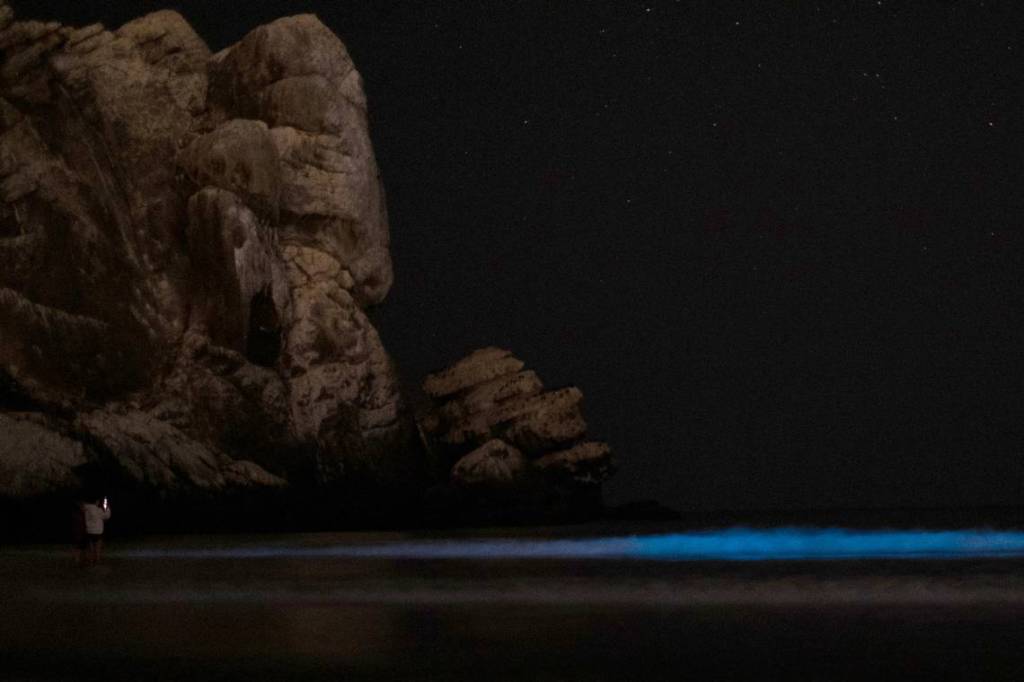News of the weird: Ocean waves are glowing blue again on California’s coast
Published 6:39 am Thursday, September 21, 2023

- Waves light up blue in Morro Bay early Saturday, Sept. 23, 2023, thanks to tiny, single-celled creatures called bioluminescent dinoflagellates that produce bursts of light when disturbed.
SACRAMENTO, Calif. — When Melanie Bryan pilots her dinghy through the Morro Bay harbor, she leaves a streak of glowing blue water in the ocean behind her.
“It’s just a splattering of turquoise-glowing blue,” Bryan said. “It’s beautiful.”
The glow is created by bioluminescent dinoflagellates, which are tiny, single-celled creatures that produce bursts of light when disturbed, according to Cal Poly biology professor Alexis Pasulka.
Waves crashing on the sand shake up the plankton — causing them to radiate green and blue light like tiny glow sticks, she explained.
“It’s a beautiful thing to see at night,” Pasulka said.
The catalyst for recent luminous waves are a type of dinoflagellate called lingulodinium polyedra, a reddish brown plankton that also cause red tides, Pasulka said.
As part of the California Harmful Algal Bloom Monitoring and Alert Program, Cal Poly’s Plankton Ecology and Coastal Oceanography Lab monitors for harmful algal blooms off of the SLO County coast.
The lab detected low numbers of these plankton at its Morro Bay test sites, Pasulka said, but there could be pockets of them elsewhere causing small sections of the coast to glow.
“These bloom spots are very patchy,” Pasulka said. “It’s not all encompassing of our coast at the moment.”
Typically, when the entire coastline glows, there are 10,000 to 100,000 cells of plankton per liter of seawater, she said.
Dinoflagellates are often seen off the San Luis Obispo County coast during late summer and early fall when the combination of nutrients and light is just right, according to Pasulka.
The blooms can last several days to several weeks depending on the conditions, she said.
“If, you know, the wind shifts and moves things out of the area, the bloom could be gone within a couple of days,” Pasulka said.
Manhattan DA returns artworks stolen by the Nazis to Holocaust victim’s heirs
NEW YORK — Works of art stolen by the Nazis from a renowned Austrian-Jewish cabaret performer more than 80 years ago were officially returned to his heirs Wednesday, Sept. 20, at a ceremony in the Manhattan district attorney’s office.
The seven drawings, collectively valued at nearly $10 million, were among dozens of artworks by late Austrian artist Egon Schiele seized in 1938 from Fritz Grunbaum, an avid art collector who died at Germany’s Dachau concentration camp during World War II.
While most of Schiele’s work was sold off to help finance the German war machine, the whereabouts of the seven drawings were unknown until they turned up in Switzerland in the late 1950s and were eventually sold to a New York-based gallery owner.
They ended up hanging on the walls of such institutions as New York’s Museum of Modern Art and in the hands of private U.S. collectors, where they remained until their seizures this year in a joint investigation by DA Alvin Bragg and the Department of Homeland Security.
“You have solved crimes perpetrated over eight decades ago. Your recovery of these artworks reminds us once again that history’s largest mass murder has long concealed history’s greatest robbery,” Grunbaum’s descendant, U.S. federal Judge Timothy Reif, said at the repatriation ceremony.
“In the more than (80) years since those pieces were ripped away from their rightful owners, they passed literally around the globe — eventually, and fortunately for purposes of our work here, traveling through New York and Manhattan,” Bragg said.
“This ceremony has reminded me that despite the horrors and the tragedy and destruction caused by the Nazis, it is never too late to teach the world about incredible people like Mr. Grunbaum.”
Ray Dowd, a lawyer for Grunbaum’s heirs, said the pieces will be auctioned at Christie’s auction house in November and hopefully fund “many, many, many scholarships.”
120 dogs rescued in major dogfighting bust by federal and SC law enforcement
COLUMBIA, S.C. — Some 120 dogs were seized Thursday, Sept. 21, following a dogfighting bust that took place across the Midlands and Upstate South Carolina, the U.S. Attorney’s Office for South Carolina has confirmed.
It is the largest single seizure of dogs from South Carolina dogfighting rings since a 60-agency effort recovered more that 300 dogs and saw the arrest of more than 20 people almost exactly one year ago.
That operation was believed to be the largest single day, single state dogfighting bust in the country. The operation is believed to have been the second largest, investigators say.
“We’ve said it before and I’ll say it again: Dogfighting operations will find no refuge here in South Carolina,” U.S. Attorney Adair Burroughs said.
The U.S. Attorneys Office confirmed that 10 search warrants were executed at properties across the Midlands and the Upstate.
Investigators from the U.S. Department of Agriculture’s Office of the Inspector General led the investigation. They were assisted by agents from SLED, the Bureau of Alcohol, Tobacco and Firearms, and local law enforcement agencies.
No federal arrests were made Thursday, the U.S. Attorneys Office confirmed. The State has contacted SLED for more information about local arrests.
Narcotics and weapons were also found during Thursday’s operation, which grew out of leads generated by the ongoing investigation from last September’s bust, investigators confirmed to The State.
The Animal Welfare Act makes it a felony punishable by up to five years in federal prison to fight dogs or to possess, train, sell, buy, deliver, receive or transport dogs intended for use in dog fighting.
Dogfighting is also illegal in South Carolina under the 1986 Animal Fighting and Baiting Act and punishable by up to five years in prison and a $5,000 fine.
San Diego closes off a sea lion hot spot popular with selfie-taking humans
SAN DIEGO — Point La Jolla, known as one of California’s prime sea lion rookeries, will no longer be accessible to the public after a unanimous vote by the San Diego City Council. The move is intended to put some space between the sea lions and intrusive human visitors.
The 8-0 vote Monday, Sept. 18, amended the city’s municipal code to keep the beach closed year-round. Last year, a city council-approved six-month closure took effect, shutting the beach from May through October.
The closure affects both Point La Jolla and adjacent Boomer Beach, a stretch of coastline of about 150 yards. The area is a top tourist attraction because California sea lions use it to rest, mate and raise their young. The closed area does not include nearby Ellen Browning Scripps Park, Shell Beach or La Jolla Cove, the site of some previous perilous encounters between the animals and visitors.
Cherlyn Cac, a senior planner with the city’s Parks and Recreation Department, said the closure was originally instituted as a “result of harassment and problematic behavior between humans and the sea lion population.” Cac said visitors would approach the wild animals and try to touch them or take selfies next to them, posing a threat to the creatures and themselves.






